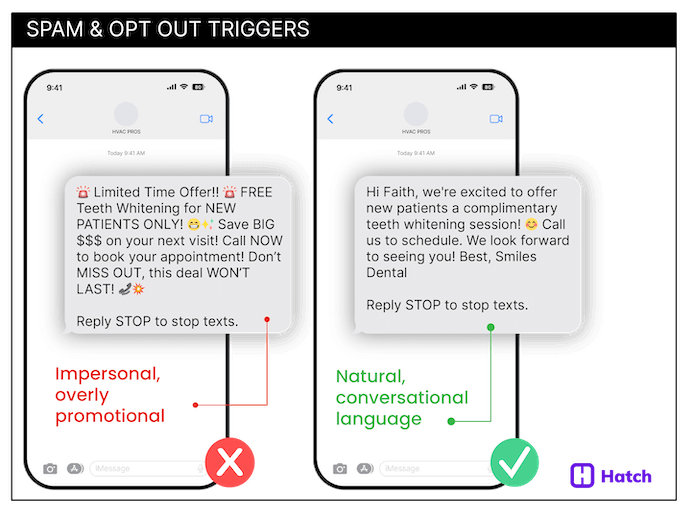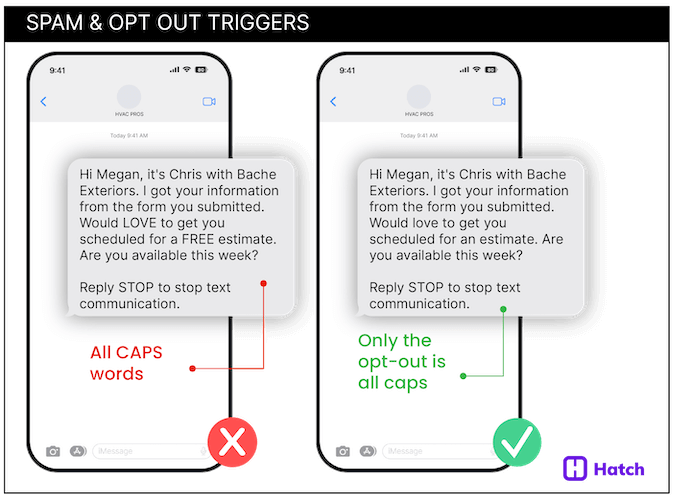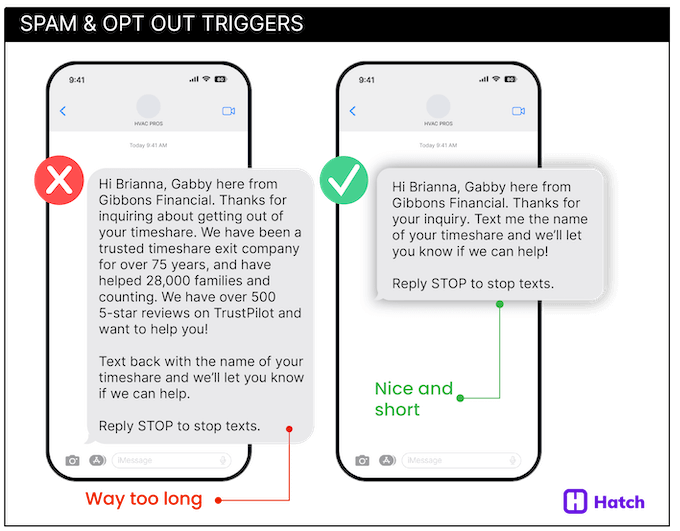Opt outs are kind of like when you’ve put in all this work to host a party and the guests start leaving. Some quietly depart. Others slam the door on their way out.
Yes, you only want to be sending messages to people who want to receive them anyway. But it’s important to make sure the people who want to receive your messages are receiving the messages that they want. This leads to higher open, response, and conversion rates.
High opt out rates are usually an indicator of poor messaging, a poor customer experience, and may lower your sender reputation among carriers.
So in this post, we're going to go over a good opt out rate to strive for and cover 10 ways to keep opt out rates low, conversion rates high, and customers happy.
What is SMS opt-out rate?
Opt out rate, also known as unsubscribe rate, indicates how frequently people are choosing not to receive communications from you.
The opt out rate formula is the number of texts generating opt outs, divided by the total number of texts sent, multiplied by 100.
SMS opt out rate = [texts generating unsubscribes / total sent texts] * 100
What’s a good opt-out rate?
What constitutes a good opt out rate will depend on your industry, your audience, and the purpose of your texting campaigns. In a survey done by Simply Texting, the most common opt out rate (for 42% of respondents) was 1-2%.

Image source
How to keep opt-out rates low
Follow these 10 best practices to ensure your messages resonate with customers, get responses, and facilitate a positive reputation for your business.
1. Get consent
Not only does consent keep opt-out rates low—since you’re texting people who want to be texted—but it is also required by law via the TCPA. To capture consent, the form you use to capture the phone numbers of consumers you’re going to text needs to have specific opt-in verbiage. This includes:
- Clear opt-in message or checkbox ("By submitting, you are authorizing…”)
- Explicit mention of text or SMS
- Company name
- Purpose of campaign
- Message frequency
- “Message and data rates apply”
- “Consent is not a condition of purchase”
- Link to SMS privacy page
- Link to SMS T&C page
Here’s an example:
By submitting your information, you are authorizing [Your Company Name] to reach out to you via phone, email, or SMS to [enter the purpose here…such as “to get more information on your service needs” or “to receive marketing communications”]. We will never share your personal information with third parties for marketing purposes. Message frequency varies. Message/data rates apply. You can opt out at any time. Consent is not a condition of purchase. [link to] Terms & Conditions. [link to] Privacy Policy.

You can learn all the details in our post on prior express written consent.
2. Maintain message relevance
This is another TCPA requirement, and for good reason. If a consumer fills out a form and the opt-in verbiage says that you’ll text them to get information on their project needs, but you’re sending them coupons and promos, they’re likely to opt out. Make sure that you’re sending only messages for which your recipients provided consent. This may mean having different forms and consent verbiage depending on the call to action or website page the form is associated with.
3. Identify yourself immediately
This is, once again, a TCPA requirement that makes sense. The first text of any campaign must include a company identifier. It’s best to put this at the start of your message so your customer knows right away that it’s you.
For example, “Hi Megan, Rob here from G&H Financial.”

4. Segment and tailor
The broader your audience, the broader your messaging has to be. But the broader your messaging, the less relevant and impactful it will be. This is why it’s more effective to divide your audience into segments so you can create messages tailored to their needs and particular stage in the customer journey.
Here are some audience segment examples:
- New leads
- Recently quoted prospects
- Aged leads who haven’t booked an appointment
- Prospects who were quoted a month ago
- Closed lost prospects due to timing
- Canceled appointments
- Customers who have signed but whose project has yet to start
- Customers with recently completed projects
- Customers who have given you a 5 star review
- Customers who have given you a 1 star review
- Membership customers with upcoming recurring services
With segments like this, you can create specific offers and messages that resonate and will keep opt-out rates low.
This is why you should look for audience targeting capabilities when considering communication platforms.
 Hatch, for example, integrates directly with your CRM and lead sources so you can create audiences based on any criteria in your database.
Hatch, for example, integrates directly with your CRM and lead sources so you can create audiences based on any criteria in your database.
5. Use natural and conversational language
This is a must with customer communication, and it applies especially to businesses that use texting for two-way conversation, such as to respond to inquiries and support requests. Make sure you word your messages so they sound like they’re coming from a human and invite a response. Avoid using too much jargon, being overly promotional, or sounding too formal.

6. Avoid spam triggers
Spam triggers are words and other message characteristics that can make the message appear to be spam. These triggers will cause your message to get filtered out by carriers, or if it does get through, it will likely get mistaken as spam by your customer and lead to an opt out.
Messages likely to trigger spam filters and opt outs are:
- Lengthy, impersonal, overly promotional, or have exaggerated claims
- Have improper nouns capitalized or words with all caps (other than the opt-out keyword)
- Contain spam trigger words like 100%, guarantee, winner, and more.
Spam triggers aren't black and white, though. Learn about them in greater depth in this post on spam triggers.

7. Keep it short
The biggest reason SMS open and response rates are high is because people prefer the short, digestible nature of texting. Send them a long message and you can be sure they’ll not respond and/or opt out. Keep messages as close to 160 characters as possible. With required compliance verbiage this isn’t always possible, so aim for a maximum of 160-320 characters.

8. Limit frequency
It can take up to eight attempts to get a lead to respond. So on the one hand, it’s important to send multiple messages. This is why Hatch automates multi-channel, multi-touch outreach.
But on the other hand, too many messages can trigger opt outs. That’s why the messages Hatch automates are part of precisely targeted campaigns with short relevant, and highly personalized sequences.
With that in mind, make sure that you’re not bombarding your contacts with multiple different campaigns and impersonal, irrelevant messages (think mass text blasts). This type of messaging frequency is sure to increase your opt out rates.
9. Respect time zones
This is an especially important consideration if you’re using a communication automation platform. You need to ensure that you’re sending messages during reasonable hours, and that you’re factoring in time zones as well. Nothing begs for an opt out like a text at two a.m.
10. Give clear opt out instructions
If I’m trying to keep opt out rates low, why would I tell my customers how to opt out? For starters, this is a TCPA requirement. But also, being clear, transparent, and reassuring your customers that they are in control is precisely the type of experience that would satisfy them and make them less likely to opt out.

Maintain a good opt-out rate with these tips
High SMS unsubscribe rates can stem from sending untimely or too many messages, failing to follow through on what you promised during the subscription process, and missing the mark with messaging. If you see high SMS unsubscribe rates, see if any of the above are potential causes and adjust your campaigns accordingly. To recap, here are 10 ways to keep opt out rates low:
- Get consent
- Maintain message relevance
- Identify yourself immediately
- Segment and tailor
- Keep it natural and conversational
- Avoid spammy language
- Keep it short
- Limit frequency
- Respect time zones
- Give clear opt out instructions
Found this post helpful?